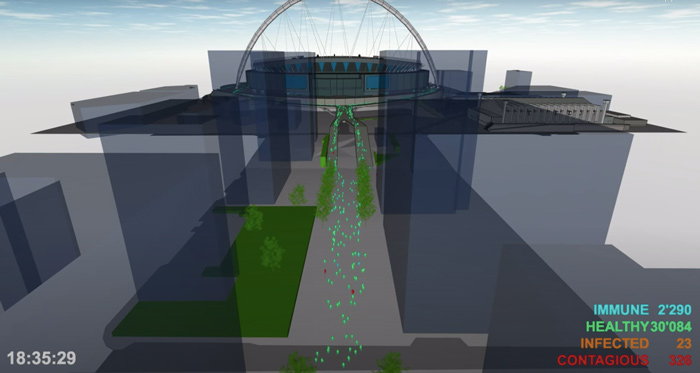Crowd Management Processes Could Help Wembley Stadium Reopen At 50% Capacity, Analysis From ONHYS Suggests
 Analysis details how major sports and entertainment venues could resume operations at up to half capacity, using appropriate crowd management measures
Analysis details how major sports and entertainment venues could resume operations at up to half capacity, using appropriate crowd management measures- Findings could have wide reaching implications for management of public spaces
Crowd management processes could enable Wembley Stadium to open its doors to 38,000 visitors, while keeping the COVID-19 reproduction rate (R-rate) at 0.11%, according to new analysis by ONHYS, a technology company specialising in pedestrian behavioural simulation. Formally launching in the UK today, ONHYS believes that the findings could see an end to football matches played behind closed doors, and could have wide-reaching implications for the management of public spaces, public health and the economy.
Using publicly available maps and visitor metrics for Wembley Stadium, ONHYS set out to understand under what conditions it would be possible to reopen the stadium whilst maintaining low contamination levels. It found that if Wembley were to host a full capacity of 76,000 spectators today without any operational changes to manage the flow of the virus, based on current virus levels, the R-rate would be 2, resulting in approximately 1,500 new infections per event only taking into consideration entry to the stadium. This would cause an exponential growth of virus in the population without considering the infections that would occur inside the stadium, and during the exit of spectators.
However, ONHYS’s analysis* suggests that if Wembley introduced measures to control the flow of pedestrians, organised different pedestrian flows around entrance gates, and enforced the use of face coverings, it could host half of its capacity while decreasing the number of infected people by 95%. According to the findings, by taking these steps to limit the spread of the virus, Wembley could manage 38,000 visitors through its entrances, while reducing the R-rate to 0.11 while the R-rate in the general population is between 1 and 1.2 (GOV.UK).
The ONHYS study focused on the stadium entrances, where the infection risk is highest. A crowd in motion has a far higher infection rate as people walk through others’ infection clouds; when seated, people only tend to infect those in their immediate surroundings. With access to further data on the inner configurations of the stadium, including internal flow and exit flow, ONHYS software could find the optimal configuration to minimise contagion levels whilst maintaining high attendance.
Sébastien Paris, CEO and founder of ONHYS, said: “While the coronavirus is still circulating in the general population it is all but impossible to eliminate the risks of infection completely. However, both public health and economic recovery depend on our ability to resume a semblance of normality as soon as possible and our public spaces comprise a major part of that. While Wembley Stadium has been holding sporting events behind closed doors and this looks set to remain the case for the foreseeable future, our analysis indicates that this approach may be overly cautious. With careful planning and by using novel scientific research we could see fans return to the stands in the near future, while keeping the overall risks of transmission down.”
ONHYS specialises in the modelling and simulation of pedestrian flows, crowd movements and user behaviours in urban spaces. ONHYS’s cutting-edge behavioural simulator ONHYS ONE combines Artificial Intelligence (AI) with Building Information Modelling (BIM) technology to simulate crowd flows in different environments.
The company recently launched its COVID-module in response to the pandemic. As the first of its kind, the module is the only software that is able to simulate the propagation of the virus in public settings such as at large venues, conference centres, public events or on public transport. Various analytical metrics can be adjusted in this simulation to assess the safety risks including population vulnerability, the number of masks worn, and the proportion of infected individuals. The software also generates heat maps to assess how the virus spreads through that particular environment.
Paris continued: “The pandemic has prompted many public spaces to close their doors to limit the spread of infection. When governments across the world begin to reopen their economies and resume normality, they must be able to do this in the safest and most effective way. Venue owners and event organisers will face the challenge of creating a safe environment for their visitors whilst also maintaining financial stability.
“The issue is that current approaches to reopening venues tend to lack scientific rigour and pay little attention to venues themselves and human behaviours. By using the ONHYS ONE software, venues can increase capacity without jeopardising public safety or business. The use of crowd simulation technology will allow decision makers to change different variables, to ensure they can reopen their businesses safely.”
*For further details about ONHYS’s study and its methodology, visit go.onhys.com/wembleystadium
















































